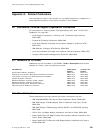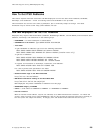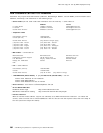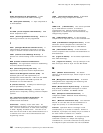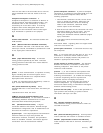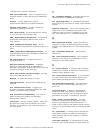This soft copy for use by IBM employees only.
from the root node to the leaf nodes and a non-zero
return bandwidth from the leaf nodes to the root
node.
multipoint-to-multipoint connection. A
multipoint-to-multipoint is a collection of ATM VC or
VP links and their associated endpoint nodes. Any
information sent on the connection by a node is
received by all of the other nodes. A receiving
endpoint node cannot distinguish which other
endpoint sent the information unless some higher
layer information is present for the purpose.
N
network node interface. The interface between two
ATM switches.
NTSC (National Television Standard Committee).
Video resolution: 525 rows x 700 vertical lines, 29.97
frames per second, transmitted as {fields/frame. Used
in US, Japan,parts of South Africa.
O
OSPF (Open Shortest Path first). A link-state
routing protocol specified by the IETF. Link-state
routing protocols scale better than vector-distance
routing protocol as RIP.
P
packet. In data communication, a sequence of binary
digits, including data and control signals, that is
transmitted and switched as a composite whole.
Synonymous with
data frame
.
In ATM, “An information block identified by a label at
layer 3 of the OSI reference model.”
PAL (Phase Alternation by Phase). Video
resolution:625 rows x 700 vertical lines, 25 frames per
second.
Standard used in most the world.
PCMCIA (Personal Computer Memory Card
International Association). An association involved in
establishing hardware standards that are often
associated with miniaturized peripherals.
PVC (Permanent Virtual Circuit). A logical
connection between end stations, defined through
administrator configuration, that is established at all
times that the network is operational.
physical layer. In the Open Systems Interconnection
reference model, the layer that provides the
mechanical, electrical, functional, and procedural
means to establish, maintain, and release physical
connections over the transmission medium.
point-to-multipoint connection. A point-to-multipoint
connection is a collection of associated ATM VC or VP
links and associated endpoint nodes, with the
following properties:
1. One ATM link, called the root link, serves as the
root in a simple tree topology. When the root
node sends information, all of the remaining
nodes on the connection, called leaf nodes,
receive copies of the information.
2. Each of the leaf nodes on the connection can send
information directly to the root node. The root
node cannot distinguish which leaf node is
sending the information without additional (higher
layer) information.
3. Leaf nodes cannot communicate directly with
each other.
ATM Forum Phase 1 signaling does not support traffic
sent from a leaf to the root.
point-to-point connection. A connection that has only
two end points.
port. (1) An access point for data entry or exit. (2) A
connector on a device to which cables for other
devices such as display stations and printers are
attached. Synonymous with
socket
.
private network to network interface. The interface
between two switches, or between a switch and a
switching subsystem. Also known as the private
network to node interface.
protocol. (1) A set of semantic and syntactic rules
that determines the behavior of functional units in
achieving communication. (2) In SNA, the meanings
of and the sequencing rules for requests and
responses used for managing the network,
transferring data, and synchronizing the states of
network components. (3) A specification for the
format and relative timing of information exchanged
between communicating parties.
protocol data unit (PDU). A unit of data specified in a
layer protocol and consisting of protocol control
information and layer user data.
R
RIP (Routing Information Protocol). A
vector-distance routing protocol.Versions of RIP are
used with IP and IPX.
S
SAP (Service Advertising Protocol). An IPX protocol
used to advertise the location of available services.
SECAM (Sequentielles Couleurs Avec Memoire).
Video resolution: 625 rows X 700 lines, 25 frames per
second.
Glossary 287



